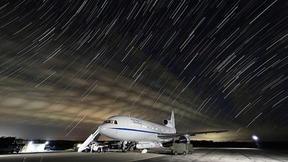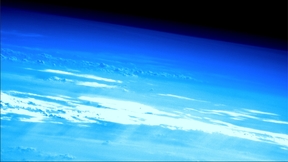Back
Space security
Big Ideas Lab podcast explores the world’s largest camera
During the next decade, the world’s newest telescope will detect about 20 billion galaxies, representing the first time a telescope will observe more galaxies than there are people on Earth. LLNL researchers designed the major optical components for the telescope camera, called the Legacy Survey of Space and Time (LSST) camera and part of the Vera C. Rubin Observatory…
Big Ideas Lab Podcast looks back at the laser guide star
Late one evening about 30 years ago, a beam of light shot into the sky from Lawrence Livermore National Laboratory (LLNL), creating confusion and awe in the surrounding community. It wasn’t a UFO, as some people feared, but the start of a revolution in astronomy. That beam of a light was a demonstration of the laser guide star, which would go on to light up the night sky…
LLNL and Starris sign agreement, schedule conference talk for Aug. 13
Lawrence Livermore National Laboratory (LLNL) and Starris: Optimax Space Systems have signed a Cooperative Research and Development Agreement (CRADA), expanding production of LLNL’s next-generation space domain awareness technology. Starris will serve as the manufacturing partner that can scale production of monolithic telescope technology to meet the needs for…
LLNL selected by Defense Innovation Unit to build Pathfinder telescope for space vehicles
Lawrence Livermore National Laboratory (LLNL) has been selected by the U.S. Department of Defense’s Defense Innovation Unit (DIU) to provide a new monolithic telescope for a responsive space mission that will launch as early as 2027. Firefly Aerospace will host and operate the payload onboard its Elytra orbital vehicle during the mission in low Earth orbit (LEO), the area…
LLNL’s high-resolution telescope system to usher in a new era of lunar exploration
Lawrence Livermore National Laboratory (LLNL) is playing a pivotal role supporting a groundbreaking lunar imaging effort in collaboration with Firefly Aerospace. A LLNL state-of-the-art telescope system will be deployed onboard Firefly’s Elytra orbital vehicle to enable Firefly’s new Ocula imaging service, as early as 2026. This marks the first planned commercial lunar…
LLNL will host watch party on June 23 to unveil Rubin Observatory’s first images
The Vera C. Rubin Observatory will release its first set of images on June 23, 2025. The achievement marks the beginning of a new era in astronomy, and Lawrence Livermore National Laboratory (LLNL) will be part of the action as it hosts a first look watch party for both staff and the public. Anyone is welcome to attend the watch party at the University of California…
Space security advances for the Big Ideas Lab podcast
Lawrence Livermore National Laboratory’s (LLNL) contributions to space security are the topic of the newest Big Ideas Lab Podcast series. Listen on Apple and Spotify. Ben Bahney, the leader of the Lab’s Space Science and Security Program, calls space security the idea that the U.S. needs to find a way to operate in space despite the presence of natural threats to…
All ears on the Big Ideas Lab podcast
Lawrence Livermore National Laboratory (LLNL) has big ideas and is showing the world in the Big Ideas Lab weekly podcast that takes listeners behind the fences and into its heart. “This is where big ideas come to life,” said Lab Director Kim Budil. “To do this, we bring together dynamic teams of many different disciplines — laser physicists and materials scientists and…
Deep Purple payload successfully deployed and operational
The Deep Purple telescope developed by Lawrence Livermore National Laboratory (LLNL) researchers is now operational in space. The Livermore instrument, which utilizes a new design for an ultra-violet (UV) and short-wave infrared monolithic telescope features a novel, compact optical system and electronics package inside a lightweight, modular housing. On Friday, Aug. 16,…
Unveiling Bennu asteroid samples
Now at Lawrence Livermore National Laboratory (LLNL) lies a piece of ancient history. Very ancient history. The material, at just 120 milligrams, will provide information about the early solar system, planetary formation, and potentially, even ingredients for life on ancient Earth. LLNL scientists recently received and will analyze samples from the asteroid Bennu that will…
Two LLNL physicists honored for international collaboration
Lawrence Livermore National Laboratory (LLNL) physicists Hye-Sook Park and George Swadling, along with Anna Grassi of France’s Sorbonne University and former Lawrence Fellow Frederico Fiuza of Portugal’s Técnico Lisboa, received the 2024 Lev D. Landau and Lyman Spitzer Jr. Award for Outstanding Contributions to Plasma Physics. The award is jointly sponsored by the Plasma…
LLNL gamma-ray sensor has the best resolution
It’s official. An instrument designed and built by Lawrence Livermore National Laboratory (LLNL) researchers is the highest-resolution gamma ray sensor that has ever flown in space. The Livermore high-purity germanium (HPGe) gamma ray sensor is an essential part of a larger gamma-ray spectrometer (GRS) built in collaboration with researchers from Johns Hopkins Applied…
Magnesium oxide undergoes dynamic transition when it comes to super-Earth exoplanets
Researchers from Lawrence Livermore National Laboratory (LLNL) and Johns Hopkins University have unlocked new secrets about the interiors of super-Earth exoplanets, potentially revolutionizing our understanding of these distant worlds. The focus of this work, magnesium oxide (MgO), a crucial component of Earth’s lower mantle, is believed to play a similar role in the…
FAA awards first approval for drone swarm testing
Lawrence Livermore National Laboratory’s (LLNL) Autonomous Sensors team has received the Federal Aviation Administration’s (FAA’s) first and — to date — only certificate of authorization (COA) allowing autonomous drone swarming exercises on the Lab main campus. These flights will test swarm controls and sensor payloads used in a variety of national security applications…
Mystery of puffy exoplanet solved
A recent study of the atmosphere of the exoplanet WASP-107b suggests tidal heating is responsible for the exoplanet’s inflated nature and reveals a previously unseen combination of molecules in an exoplanet. A Lawrence Livermore National Laboratory (LLNL) scientist and international collaborators have characterized the atmosphere of the exoplanet, WASP-107b, using a…
Lab to provide optical payload for upcoming U.S. Space Force mission
Lawrence Livermore National Laboratory’s (LLNL) Space Program is now building an optical space domain awareness payload for an upcoming mission by the U.S. Space Force. The planned mission, known as VICTUS HAZE, will be a tactically responsive space mission to demonstrate the ability to rapidly characterize an on-orbit threat. The U.S. Space Force selected Long Beach,…
LLNL Pandora SmallSat mission clears major NASA milestone on the path toward launch
Lawrence Livermore National Laboratory’s (LLNL) Pandora SmallSat mission recently passed NASA’s critical design review: a major milestone for the mission to continue its journey toward launch. The Pandora SmallSat mission will study planets beyond our solar system, known as exoplanets, and their stars. “This is a major milestone for the mission and a huge accomplishment…
New nuclear deflection simulations advance planetary defense against asteroid threats
Researchers at Lawrence Livermore National Laboratory (LLNL) have developed a modeling tool for assessing the potential use of a nuclear device to defend the planet against catastrophic asteroid impacts. The research, published today in the Planetary Science Journal, introduces a novel approach to simulating the energy deposition from a nuclear device on an asteroid's…
LLNL’s prototype telescope now fully operational aboard the International Space Station
When SpaceX’s Dragon spacecraft docked with the International Space Station (ISS) on March 16, it delivered several thousand pounds of supplies for the crew as well as new hardware. The hardware included the U.S. Space Force’s Space Test Program Houston 9 (STP-H9) platform, which houses a prototype telescope designed and built by Lawrence Livermore National Laboratory's…
#YourPlaceInSpace: LLNL planetary defender promotes career opportunities in the federal space workforce
Planetary defense physicist Megan Bruck Syal on Wednesday represented Lawrence Livermore National Laboratory (LLNL) at “Space STEM Task Force Pathways to the Federal Space Workforce,” an outreach event hosted by the National Science Foundation. Multiple federal government agencies came together in a virtual interactive session to provide information for students, early…

























